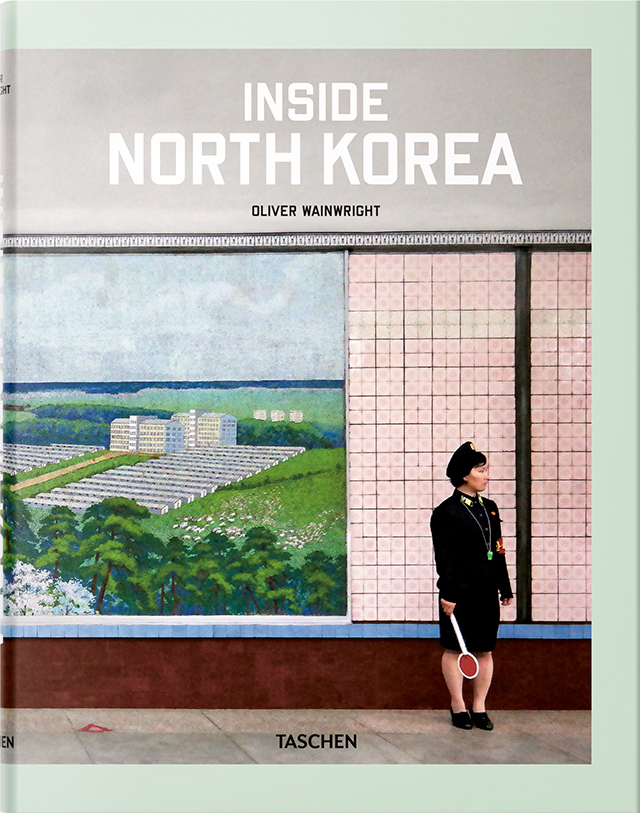Inside North Korea
Inside North KoreaOliver WainwrightTaschen, August 2018Hardcover | 8-1/4 x 10-3/4 inches | 240 pages | 200 illustrations | English/German/French | ISBN: 978-3836572217 | $60.00PUBLISHER'S DESCRIPTION: Erased by bombing during the Korean War, North Korea’s trophy capital of Pyongyang was entirely rebuilt from scratch from 1953, in line with the vision of the nation’s founder, Kim Il Sung. Designed as an imposing stage set, it is a place of grand axial boulevards linking gargantuan monuments, lined with stately piles of distinctly Korean flavor, to be “national in form and socialist in content.” Under the present leader, Kim Jong Un, construction has ramped up apace—“Let us turn the whole country into a socialist fairyland,” declares one of his official patriotic slogans. He is rapidly transforming Pyongyang into a playground, conjuring a flimsy fantasy of prosperity and using architecture as a powerful anesthetic, numbing the population from the stark reality of his authoritarian regime. Guardian journalist and photographer Oliver Wainwright takes us on an eye-opening tour behind closed doors in the most secretive country in the world, revealing that past the grand stone façades lie lavish wonder-worlds of marble and mosaic, coffered ceilings, and crystal chandeliers, along with new interiors in dazzling color palettes. Discover the palatial reading rooms of the Grand People’s Study House, and peer inside the locker rooms of the recently renovated Rungrado May Day Stadium, ready to host a FIFA World Cup that will never come. Oliver Wainwright is the architecture and design critic at The Guardian. Trained as an architect, he worked for OMA in Rotterdam and for the Mayor of London’s Architecture & Urbanism Unit. ... His photographs have been exhibited internationally and are regularly used to illustrate his articles. REFERRAL LINKS: dDAB COMMENTARY: I'd wager that a lot of people outside of North Korea — architects and non-architects alike — know the architecture of its capital, Pyongyang, through one building, the Ryugyong Hotel. At more than 100 floors, it is easily the tallest building in the city, but it is also known for its difficult realization. Construction started in 1987, but it sat as an empty shell from 1992 to 2011, when it was wrapped in glass and entered the international media. That year coincided with the death of Kim Jong Il, the second leader of North Korea and the one who penned the 170-page architectural treatise "On Architecture" (PDF link) in 1991. Ryugyong Hotel appears in the background of a few photographs in Oliver Wainwright's eye-opening Inside North Korea, but he did not discuss it, neither in the introduction nor in the captions to the photos where it makes itself known. Instead, the Guardian architecture critic who took readers inside Pyongyang in September 2015 trains his eye on other buildings "inside Pyongyang's candy-colored mirage." Given that foreigners visiting North Korea are always escorted as they move about the country, and the tours they go on are highly scripted toward emboldening the nation's image, the sights Wainwright is presenting must also be the ones the Korean government wanted him to see and allowed him to set foot inside. The 105-story tower, still unfinished and empty inside per most reports, would hardly be part of that tour, regardless of its omnipresence on the capital city's skyline. Released in 2018, right around the time of the historic meeting of U.S. President Donald Trump and Kim Jong Un, Kim Jong Il's son and successor, Wainwright's book of photographs he took in 2015 is not the first architectural peek inside North Korea. Three years earlier came Architectural and Cultural Guide Pyongyang from DOM Publishers, which has two volumes: one an official guide from the Pyongyang Foreign Languages Publishing House, and the second collecting essays by editor Philip Meuser and other contributors. That guidebook's first volume presents buildings by typology: Urban Planning, Residential Buildings, Cultural Venues, Education and Sport, Hotels/Department Stores, Transport Infrastructure, and Monuments. Wainwright's book is strikingly similar in its chapters: City Views and Housing, Monuments, Museums and the Art, Sports and Education, Leisure and Hospitality, and Pyongyang Metro. The similarities hint at the official itineraries that foreign visitors must follow, while more importantly they express exactly where the Communist government devotes its architectural efforts. When Wainwright spoke at the Architecture & the Media symposium in May, he said he doesn't consider himself a photographer. Regardless, I think he's a very talented one (in 2106 I included him in a list of my favorite Instagram accounts), and the book is especially good because of that. He captured many aspects of Pyongyang's urban landscape, giving readers a sense of the city's mix of monotony and color, but he also captured the interiors of buildings that show these traits

Inside North Korea
Oliver Wainwright
Taschen, August 2018
Hardcover | 8-1/4 x 10-3/4 inches | 240 pages | 200 illustrations | English/German/French | ISBN: 978-3836572217 | $60.00
PUBLISHER'S DESCRIPTION:
REFERRAL LINKS:
SPREADS:










